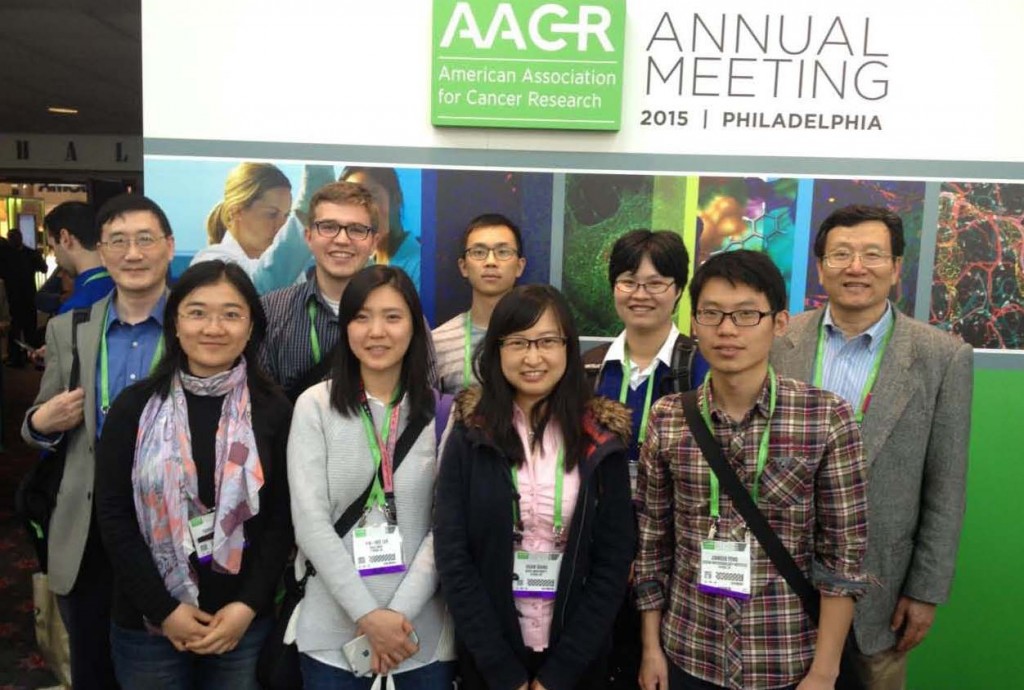Dr. Shiyong Wu, Director of Edison Biotechnology Institute and Professor of Chemistry & Biochemistry, and Dr. Xiaozhuo Chen, Associate Professor of Biomedical Sciences, and their research teams attended the meeting and presented their novel discoveries in cancer research at the 2015 American Association for Cancer Research annual meeting in Philadelphia from April 18-22. The two are Molecular and Cellular Biology faculty members.
The meeting highlighted the latest, most exciting discoveries in every area of cancer research and provided a unique opportunity for investigators from all over the world to meet, interact, and share their insights.
This year’s meeting theme “Bringing Cancer Discoveries to Patients” underscored the vital and inextricable link between discovery and treatment, and it reinforces the fact that research underpins all the progress scientists are making in the field toward cancer cures.
The Ohio University presenters included:
Dr. Yanrong Qian ’14 and Xuan Wang presented “Extracellular ATP is internalized through not only macropinocytosis but also other endocytic processes and promotes growth of human lung cancer cells with Ras mutations.” Co-authors were Xuan Wang, Yunsheng Li, Yanyang Cao, Shiyong Wu, and Xiaozhuo Chen. Travel was funded by the Konneker Research Fund and the he John J. Kopchick MCB/TBS Research Fellowship Award.
Abstract: Within a tumor, extracellular ATP (exATP) concentrations are in the range of several hundred micromolars or higher, 103-104 times higher than those in normal tissues. We recently showed that extracellular ATP, within the intratumoral concentrations, was internalized by Ras-mutated (Rasmut) A549 human lung cancer cells through macropinocytosis, elevated intracellular ATP levels and rescued cancer cells under various stresses. However, macropinocytosis alone could not account for all the elevated intracellular ATP increase. Here, we show that other endocytic processes, in addition to macropinocytosis, also contributed to the internalization of exATP in A549 and H1299 human lung cancer cells. Cell viability assays, intracellular ATP luminescence measurement assays, fluorescent microscopy were used in this study. First, high-molecular-weight (HMW) dextran uptake assay indicated that A549 and H1299, both Rasmut cancer cells, exhibited a phenotype of macropinocytosis. The colocalization of the red fluorescent HMW dextran and green nonhydrolyzable ATP analog inside the cells indicated that extracellular ATP was internalized by macropinocytosis. In contrast, significantly fewer macropinosomes were found in NL-20 noncancerous lung cells. In addition, the colocalization of low-molecular-weight (LMW) dextran, an endocytic tracer, and ATP analog indicated the internalization of exATP through non-macropinocytic-endocytosis in both lung cancer cell lines. Interestingly, when both red HMW dextran and green LMW dextran were applied to cancer cells, not only colocalization, but also some green-only endosomes were observed, strongly suggesting that both endocytic processes were responsible for exATP internalization. Collectively, these data indicated for the first time that other endocytic processes in addition to macropinocytosis contributed to the internalization of exATP in human lung cancer cells with Rasmut. This finding may significantly enhance our understanding of energy hemostasis within cancer cells and the Warburg effect, which in turn facilitates the development of anticancer therapeutics targeting the endocytic processes and Ras mutations as well as novel anticancer strategies.
Dr. Lingying Tong ’14, presented “The role of carnosol in protecting UVB-induced skin damage and skin cancer progression.” The co-author was Shiyong Wu. Travel was funded by the Konneker Research Fund.
Abstract: Carnosol is a natural compound extracted from rosemary and sage, which are commonly used in traditional Mediterranean cuisine. Among all the compounds extracted from Mediterranean herbs, carnosol, first isolated from sage in 1941, has been demonstrated to be beneficial to health for its anti-inflammation, anti-oxidation and anti-cancer properties. Because of its structure similarity to sex hormones, research has been done on the effect of carnosol mainly on breast and prostate cancers. However, very little is known on the effect of carnosol on UV-induced skin cancer. In this report, we studied the effect of carnosol on UV-induced skin cancer formation and progression. Our data showed that carnosol could partially reduce UVB-induced reactive oxygen species (ROS) elevation and thus protect UV-induced DNA damage in normal skin cells. We also showed that carnosol could inhibit the UVB-induced NF-κB activation. As a result, the normal cell apoptosis induced by UV radiation was partially protected. Moreover, it could also prohibit skin cancer cell progression with or without UV radiation. Therefore, we propose that carnosol could be a potential therapeutic for chemoprevention and treatment of UVB-induced skin cancers.
Dr. ShinHee Lee and Phillip Craigmile presented “Ionizing radiation regulates mutant p53-mediated cancer cell migration through targeting cyclin D1.” C0-authors were Phillip Craigmile and Shiyong Wu. Travel was funded by the Gladys Millers Cancer Research Fund and the the John J. Kopchick MCB/TBS Research Fellowship Award.
Abstract: Ionizing radiation (IR) is widely used as a main treatment for solid tumors, however, its potential influence and its role in the invasion and metastasis of cancer still remain unknown. In this study, we found that IR showed an inhibitory effect on the invasion of mutant p53 expressing cancer cells through targeting cyclin D1, which has been known as implicated in invasion and metastasis. Our data showed that gamma-irradiation (5 Gy) decreased trans-well migration of mutant p53 expressing cancer cells. It has been reported that following exposure to IR cyclin D1 is rapidly degraded via the ubiquitin pathway. We showed that IR-induced cyclin D1 degradation is restored after 24 hr in H1299 p53 negative cells. In contrast, cyclin D1 depletion was not recovered in H1299 mutant p53 cells, suggesting its inhibiting effect on cyclin D1 regulation. In addition, the levels of matrix metalloproteinase 9 were decreased in mutant p53 expressing cancer cells, indicating the reduction of cell migration and invasion. These data indicate that IR suppresses the restoration of cyclin D1 via the mutant p53, thus inhibiting the invasion of cancer cells expressing mutant p53.

















Comments